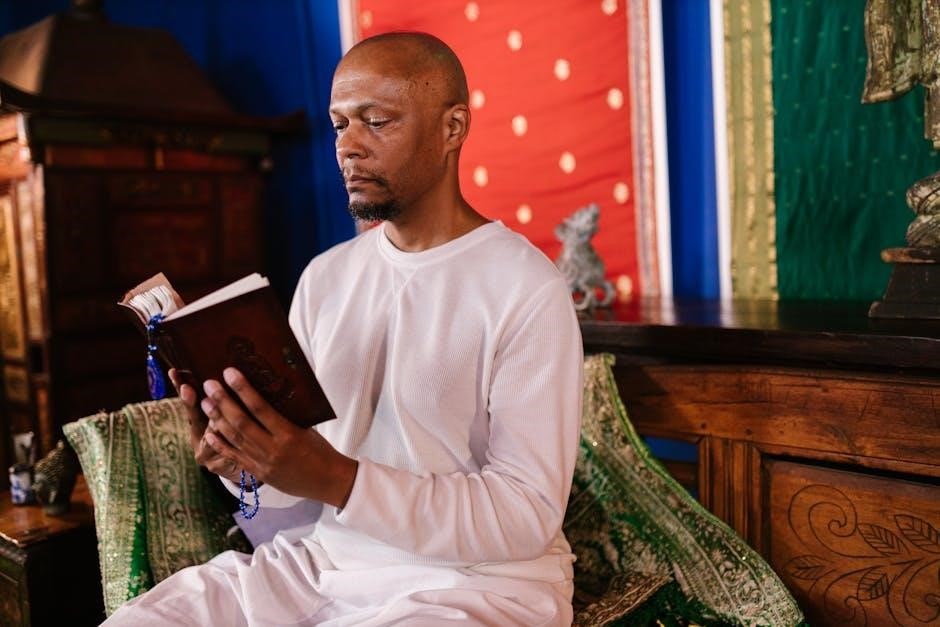
Carl Jung, a renowned psychologist, crafted The Red Book, a seminal work documenting his inner journey (1913-1930). Published in 2009, it reveals his symbolic exploration of the unconscious, blending calligraphic text with vibrant illustrations, offering profound insights into the human psyche.
Overview of Carl Jung’s Life and Work
Carl Jung, a Swiss psychiatrist, is renowned for founding analytical psychology and concepts like the collective unconscious and archetypes. Born in 1875, Jung initially collaborated with Sigmund Freud but later developed his own theories. His work explores the human psyche, blending psychology, philosophy, and spirituality. Jung’s writings, including The Red Book, reveal his deep exploration of the unconscious and personal transformation. His ideas have profoundly influenced psychology, culture, and spirituality, making him one of the most significant thinkers of the 20th century. Jung’s legacy continues to inspire research into the human mind and its mysteries.
The Significance of The Red Book in Jung’s Oeuvre
The Red Book is a pivotal work in Carl Jung’s oeuvre, representing his most intimate and transformative journey into the unconscious. It captures his unique blend of psychology, philosophy, and spirituality, offering profound insights into the human psyche. The book bridges Jung’s early collaboration with Freud and his later development of analytical psychology. Its symbolic content, active imagination, and exploration of individuation make it a cornerstone of his theories. As a manuscript, it embodies Jung’s personal and professional evolution, providing a window into his inner world and the origins of his groundbreaking concepts. The Red Book is a testament to Jung’s visionary approach to the human experience;

The Historical Context of The Red Book
The Red Book emerged during a period of personal and societal upheaval, reflecting Jung’s inner turmoil and the broader cultural shifts of the early 20th century.
Jung’s Confrontation with the Unconscious
Jung’s confrontation with the unconscious, documented in The Red Book, began during a period of intense psychological turmoil around 1913. This era marked his separation from Freud and a deep exploration of his inner world. Through active imagination, Jung engaged with symbolic figures and visions, recording his experiences meticulously. He encountered archetypes like the Shadow, Anima, and Self, which became central to his theory of the collective unconscious. This journey, fraught with emotional and intellectual challenges, laid the groundwork for his concept of individuation and the integration of opposites. It was a pivotal moment in his personal and professional development.
The Period of Its Creation (1913-1930)
The Red Book, or Liber Novus, was created by Carl Jung between 1913 and 1930, a period marked by profound psychological exploration. During this time, Jung immersed himself in active imagination, documenting visions and dialogues with symbolic figures. The work reflects his confrontation with the unconscious, blending calligraphic text with intricate illustrations. This creative process was central to Jung’s development of key psychological concepts, such as the collective unconscious and individuation. The period culminated in a deeply personal and philosophical manuscript, which remained private until its publication in 2009, offering insights into Jung’s transformative inner journey.

The Structure and Content of The Red Book
The Red Book is divided into seven sections, blending calligraphic text with symbolic imagery. Written in Latin, it reflects Jung’s active imagination and philosophical introspection, offering profound insights.
The Liber Novus and Its Seven Sections
The Liber Novus, or “New Book,” comprises seven distinct sections that chronicle Jung’s deep exploration of the unconscious. Each section delves into various facets of his inner world, blending vivid imagery with profound introspection. The first sections introduce foundational concepts, while subsequent parts explore symbolic narratives and philosophical musings. The final sections synthesize Jung’s insights, offering a cohesive understanding of the psyche. Together, these sections form a intricate tapestry that reflects Jung’s transformative journey and his revolutionary ideas in psychology.
The Calligraphic Volume and Its Illustrations
The Red Book’s calligraphic volume is renowned for its exquisite craftsmanship and symbolic illustrations. Jung meticulously copied the original text into a beautifully illuminated manuscript, adorned with intricate calligraphy and vibrant paintings. These visuals are not mere decorations but integral to the text, reflecting Jung’s inner experiences and archetypal encounters. The illustrations, rich in symbolism, depict themes of transformation, spirituality, and the collective unconscious. This fusion of text and image creates a multisensory experience, making the Red Book a unique blend of art and psychology. Its visual grandeur underscores Jung’s vision of the interconnectedness of creativity and the psyche.

Jung’s Journey into the Unconscious
Jung’s journey into the unconscious began in 1913, marked by intense visions and active imagination. He encountered symbolic figures, exploring the collective unconscious and archetypes, shaping his theories.
The Process of Active Imagination
Active imagination was a pivotal technique in Jung’s exploration of the unconscious, involving deliberate engagement with fantasies, images, and emotions. Through writing, drawing, and introspective dialogue, Jung interacted with his unconscious mind, fostering a deeper connection between the conscious and unconscious realms. This process facilitated the emergence of symbols and archetypes, crucial for psychological integration. By actively imagining and documenting these experiences, Jung gained profound insights into the collective unconscious, ultimately shaping his theories on individuation and the universal aspects of human psychology. This method remains a cornerstone of Jungian psychotherapy, aiding individuals in their own journeys of self-discovery and psychological healing.
Encounters with Archetypes: The Shadow, Anima, and Self
In The Red Book, Jung extensively explores the archetypes of the Shadow, Anima, and Self, which he encountered through active imagination. The Shadow represents repressed thoughts and desires, while the Anima embodies the feminine aspect in males, influencing relationships and emotional depth. The Self symbolizes the central archetype of wholeness and the goal of individuation. Jung’s encounters with these archetypes revealed their universal presence in the collective unconscious, shaping his understanding of human psychology. These interactions are central to his concept of psychological integration and the journey toward self-realization, offering profound insights into the structure of the human psyche.

Key Psychological Concepts in The Red Book
The Red Book explores active imagination, the collective unconscious, archetypes, and individuation. It delves into the process of integrating the psyche and the persona.
The Collective Unconscious and Archetypes
In The Red Book, Carl Jung introduces the concept of the collective unconscious, a shared psychological reservoir containing universal symbols called archetypes. These archetypes, such as the Mother, Father, and Child, appear across cultures and time, reflecting shared human experiences. Jung explores how these archetypes emerge in dreams, myths, and fantasies, serving as a bridge between the personal and collective psyche. The Red Book illustrates this theory through vivid imagery and symbolic narratives, showing how archetypes guide individuation, the process of integrating the unconscious into consciousness. This concept remains central to Jung’s depth psychology, offering insights into the universal language of the human psyche.
The Process of Individuation
In The Red Book, Carl Jung explores the process of individuation, a central concept in his psychology. Individuation refers to the integration of the opposites—conscious and unconscious, rational and emotional, masculine and feminine—into a unified whole. This process fosters self-realization and psychological wholeness. Jung depicts this journey through symbolic narratives, emphasizing the confrontation with the shadow and the anima. The Red Book illustrates how individuation requires active engagement with the unconscious, leading to the emergence of the Self. This transformative process is both personal and universal, reflecting humanity’s quest for meaning and integration.

Cultural and Philosophical Influences
Jung’s Red Book reflects influences from Gnosticism, alchemy, and mysticism, blending spiritual and philosophical traditions. Eastern philosophies like Buddhism and Taoism also shaped his ideas on the psyche.
Gnosticism, Alchemy, and Mysticism
The Red Book is deeply influenced by Gnosticism, alchemy, and mysticism. Jung draws parallels between alchemical processes and psychological transformation, viewing the journey of individuation as akin to the alchemical quest for the philosopher’s stone. Gnostic themes of hidden knowledge and the divine spark within resonate with Jung’s concept of the unconscious. Mystical traditions, such as the pursuit of unity and transcendence, are also reflected in the text. These influences enrich the symbolic imagery and philosophical depth of the Red Book, making it a bridge between ancient wisdom and modern psychology.
Influence of Eastern Philosophy and Religion
Carl Jung’s Red Book reflects influences from Eastern philosophy and religion, particularly Buddhism and Taoism. The concept of the Self in Buddhism aligns with Jung’s archetype of the Self, representing psychological wholeness. Taoist principles of yin and yang mirror Jung’s process of individuation, emphasizing the integration of opposites. Active imagination, a technique Jung developed, parallels Eastern meditative practices aimed at accessing deeper consciousness. The mandala, a symbol in Hinduism and Buddhism, is also used by Jung to represent the Self. Jung’s study of Eastern texts and interactions with Eastern thinkers enriched his synthesis of Western psychology with Eastern spirituality, enhancing the universality of his work.

The Publication and Reception of The Red Book
The Red Book, published in 2009 by W.W. Norton & Company, was initially circulated privately among Jung’s circle. Its public release sparked intense interest and debate, with scholars praising its depth while others found its esoteric content challenging. The book became a cultural phenomenon, bridging psychology, art, and spirituality, solidifying Jung’s legacy as a visionary thinker.
The History of Its Publication in 2009
The Red Book was first published in 2009 by W.W. Norton & Company, nearly 50 years after Jung’s death. The publication was a landmark event, as the book had been kept private for decades. Jung’s heirs initially resistant to its release, but growing academic interest led to its publication. The edition, edited by Sonu Shamdasani, included a facsimile of Jung’s original calligraphic text and illustrations, along with extensive commentary. The publication marked a significant milestone in the study of Jung’s work, offering unparalleled insight into his inner world and creative process.
Critical Reception and Impact on Modern Psychology
The Red Book received widespread critical acclaim upon its release, hailed as a groundbreaking work in depth psychology. Scholars and psychologists praised its depth, creativity, and insight into the human psyche. The book has significantly influenced modern psychology, offering a unique perspective on the unconscious mind and the process of individuation. Its publication sparked renewed interest in Jungian theory, inspiring new research and applications in psychotherapy. The Red Book is now regarded as a foundational text, bridging psychology, philosophy, and spirituality, and continues to inspire interdisciplinary dialogue and personal transformation.

The Red Book as a Spiritual and Philosophical Text
The Red Book is a profound spiritual and philosophical exploration, blending psychology with mysticism and Gnosticism. It offers universal truths, seeking to connect the individual with the divine, emphasizing the numinous and the pursuit of meaning in a fragmented world. Jung’s work transcends psychology, becoming a spiritual guide for self-discovery and enlightenment, resonating with seekers of deeper truths across cultures and time.
Comparisons to Religious and Mystical Texts
The Red Book draws parallels with sacred texts like the Bible, Upanishads, and Gnostic scriptures, offering a visionary narrative rich in symbolism. Its themes of divine encounter, self-discovery, and transformation echo mystical traditions, positioning it as a modern spiritual text. Jung’s exploration of the collective unconscious aligns with universal mystical experiences, bridging psychology and spirituality. The book’s prophetic tone and symbolic imagery invite readers to reflect on existential questions, much like religious texts, making it a profound resource for seekers of meaning and transcendence in a secular age.
The Role of the Numinous and the Divine
The Red Book is deeply infused with the numinous, a term Jung used to describe the awe-inspiring, transcendent quality of divine experience. The text abounds with encounters of divine figures, such as Elijah, Salome, and the Holy Spirit, symbolizing the presence of the sacred in the psyche. Jung’s journey into the unconscious reveals the divine as an active, transformative force, guiding the process of individuation. The numinous experience, often accompanied by a sense of mystery and wonder, underscores the interconnectedness of the human soul with universal, archetypal forces, blurring the lines between psychology and spirituality.

Personal Transformation and The Red Book
The Red Book chronicles Jung’s profound self-discovery, revealing how his inner journey transformed his psyche and laid the groundwork for his theory of individuation.
Jung’s Personal Myth and Symbolic Exploration
The Red Book captures Jung’s deeply personal journey into his unconscious, where he explored his own myth through symbolic visions and dialogues with archetypes. By engaging in active imagination, Jung uncovered the universal patterns of the collective unconscious, which he later termed archetypes. His encounters with figures like the Shadow, Anima, and Self reveal his struggle to integrate these elements into his psyche. The book’s vibrant illustrations and calligraphic text mirror the symbolic language of his inner world, offering a visual and textual testament to his transformative process. This exploration became the foundation for his concept of individuation, a psychological path toward wholeness.
The Role of the Reader in Engaging with The Red Book
The Red Book invites readers to embark on a deeply personal journey, mirroring Jung’s own exploration of the unconscious. It demands active engagement, urging readers to reflect on their own psyche and experiences. The text and images are not passive; they serve as a catalyst for self-discovery, encouraging individuals to confront their shadow, anima, and the process of individuation. The reader’s interpretation becomes integral to the book’s meaning, as its symbolic language resonates uniquely with each person. This interactive dynamic transforms The Red Book into a living, evolving guide for personal transformation and psychological insight.

The Legacy of The Red Book
The Red Book’s legacy endures as a foundational text in depth psychology, inspiring new psychotherapeutic approaches and shaping contemporary understanding of the human psyche.
Its Influence on Depth Psychology and Psychotherapy
The Red Book has profoundly shaped depth psychology, offering unparalleled insights into the unconscious and archetypes. Its publication revitalized Jungian analysis, inspiring therapists to explore symbolic meanings and inner transformations. The book’s emphasis on active imagination and individuation has influenced modern psychotherapeutic practices, encouraging a deeper engagement with the psyche. Its rich imagery and philosophical depth continue to inspire scholars and practitioners, fostering a holistic understanding of mental health. As a result, The Red Book remains a cornerstone in the evolution of psychotherapy, bridging psychology and spirituality.
Future Implications for Understanding the Human Psyche
The Red Book offers profound insights into the collective unconscious, archetypes, and the process of individuation, which continue to inspire future explorations of the human psyche. Its exploration of symbolic imagery and active imagination provides a framework for understanding unconscious processes. As psychology evolves, The Red Book’s emphasis on personal transformation and the integration of opposites may deepen our understanding of mental health and spirituality. Its interdisciplinary relevance to philosophy, religion, and science ensures its enduring influence, inviting future scholars to explore its mysteries and apply its principles to contemporary psychological and philosophical inquiries.
Leave a Reply
You must be logged in to post a comment.